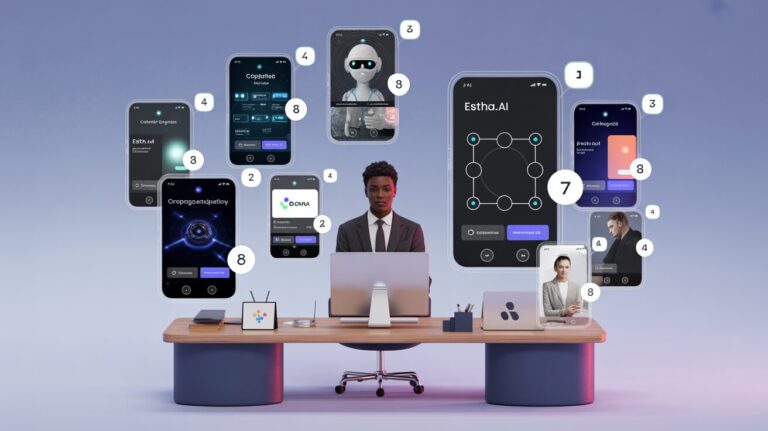Table Of Contents
- Understanding Legal Document Summarisation
- Challenges in Legal Document Processing
- Benefits of AI-Powered Legal Document Summarisers
- Creating a Legal Document Summariser with No-Code AI
- Customisation Options for Legal Document Summarisers
- Real-World Applications and Use Cases
- Future of Legal Document Processing
- Conclusion
In today’s fast-paced legal environment, professionals face the daunting challenge of processing vast amounts of complex documentation under tight deadlines. Legal documents—from contracts and case law to regulatory filings and discovery materials—can span hundreds or even thousands of pages of dense, technical text. Manually reviewing and extracting key information from these documents is not only time-consuming but prone to human error and inconsistency.
This is where AI-powered legal document summarisers have become game-changers in the legal industry. These intelligent tools can rapidly analyze legal texts, identify critical information, and generate concise summaries that capture the essential points without losing important context or nuance. However, until recently, creating such specialized AI tools required extensive programming knowledge or significant financial investment in pre-built solutions that might not fully address unique workflow needs.
Enter the era of no-code AI platforms. This article explores how legal professionals can build custom document summariser workflows tailored to their specific requirements—without writing a single line of code. We’ll walk through the complete process of creating an efficient, AI-powered legal document summarisation system using Estha’s revolutionary no-code platform, empowering legal teams to save time, reduce costs, and enhance the accuracy of their document processing workflows.
Build Your No-Code Legal Document Summariser
An efficient AI-powered workflow for legal professionals
Define Your Requirements
- Identify document types to process
- Choose desired output formats
- Plan integration with existing systems
Design Your Workflow
- Map document intake process
- Configure pre-processing steps
- Plan review and output distribution
Build Your Application
- Create interface using drag-and-drop
- Configure AI processing components
- Link components visually without coding
Test & Refine
- Process sample documents
- Compare with manual summaries
- Iterate based on testing results
Deploy & Integrate
- Configure user access & permissions
- Connect to existing systems
- Implement continuous feedback loops
Key Benefits of No-Code Legal Document Summarisers
Time Savings
Reduce document review time by up to 80%
Consistency
Apply standardized processing methodology
Enhanced Accuracy
Reduce human error in document processing
Cost Reduction
Lower expenses for document processing
Practical Applications
Due Diligence
Quickly process contracts to identify risks during M&A
Case Law Research
Distill court opinions to extract relevant precedents
Contract Management
Extract key dates, terms, and obligations automatically
No coding knowledge required • Build in minutes • Customize for your specific needs
Understanding Legal Document Summarisation
Legal document summarisation is the process of condensing lengthy legal texts into shorter, more digestible versions while preserving key information and maintaining accuracy. Unlike general text summarisation, legal document processing requires specialized attention to terminology, precedents, obligations, rights, conditions, and other legally significant elements that might be overlooked by standard summarisation methods.
There are two primary approaches to legal document summarisation:
Extractive summarisation involves selecting and presenting the most important sentences from the original document verbatim. This method preserves the exact language of the source material, which can be crucial for legal accuracy, but may result in less cohesive summaries.
In contrast, abstractive summarisation generates entirely new text that captures the essence of the original document. This approach produces more readable summaries but requires sophisticated natural language understanding to ensure legal precision isn’t sacrificed for brevity.
The most effective legal document summarisers typically combine both approaches, extracting critical passages while generating connective text and condensing repetitive sections. This hybrid method delivers summaries that are both accurate and readable—essential qualities for legal professionals making decisions based on these distillations.
Challenges in Legal Document Processing
Legal documents present unique challenges for automated summarisation that go beyond those of general text processing:
Specialized terminology: Legal texts contain domain-specific language and terms of art with precise meanings that must be correctly interpreted and preserved in summaries.
Document structure complexity: Legal documents often have hierarchical structures with sections, subsections, clauses, and subclauses that create intricate relationships between different parts of the text.
Critical nuance: Small details in legal documents can have significant implications. Words like “shall,” “may,” or “must” indicate different levels of obligation that summarisation systems need to recognize and maintain.
Context dependency: Legal language often relies heavily on context, with terms defined early in a document and referenced throughout. Summarisers need to track these definitions and their implications.
Domain variation: Different legal specialties (contracts, patents, case law, legislation) have distinct formats and conventions that require specialized handling.
Traditional AI approaches to these challenges required extensive coding expertise and custom development work. However, modern no-code AI platforms have democratized access to sophisticated document processing capabilities, allowing legal professionals to create custom solutions that address these specific challenges without programming knowledge.
Benefits of AI-Powered Legal Document Summarisers
Implementing AI-powered legal document summarisation brings numerous advantages to law firms, corporate legal departments, and legal service providers:
Dramatic time savings: Automated summarisation can reduce document review time by up to 80%, allowing legal professionals to focus on analysis and strategic work rather than reading extensive texts.
Consistency in processing: AI systems apply the same methodology across all documents, eliminating variations that occur with multiple human reviewers and reducing the risk of missed information.
Enhanced accuracy: Well-designed AI summarisers can identify critical information with greater reliability than manual review, especially when dealing with fatigue from reviewing lengthy documents.
Cost reduction: By accelerating the document review process, organizations can significantly lower the cost of legal services, whether for internal operations or client billing.
Scalability: AI systems can handle fluctuating document volumes without requiring additional staffing, making them ideal for managing periodic surges in document processing needs.
Improved client service: Faster document processing enables quicker response times to clients and more competitive service offerings.
Knowledge management: Summarised documents are easier to catalog, search, and reference, creating valuable institutional knowledge bases.
With the emergence of no-code AI platforms like Estha, these benefits are now accessible without the traditional barriers of technical expertise or extensive development resources.
Creating a Legal Document Summariser with No-Code AI
Building a custom legal document summariser using a no-code AI platform involves several key steps. Let’s explore how to create an effective workflow using Estha’s intuitive drag-drop-link interface:
Step 1: Defining Your Summariser Requirements
Before building your application, clearly define what you need your legal document summariser to accomplish:
Document types: Determine which types of legal documents your summariser will process (contracts, briefs, legislation, depositions, etc.).
Output format: Define how you want summaries structured—bullet points of key facts, executive summaries, section-by-section breakdowns, or extraction of specific elements like obligations and deadlines.
Integration needs: Consider how the summariser will fit into your existing workflows. Will it need to connect with document management systems, case management software, or client portals?
Customisation level: Decide whether you need different summarisation approaches for different document types or whether users should be able to adjust parameters like summary length or focus areas.
Documenting these requirements provides a clear roadmap for the application design phase and ensures the final product will meet your specific needs.
Step 2: Designing Your Workflow
Map out the logical flow of your document summarisation process from input to output:
Document intake: How will documents enter the system? Options include direct uploads, email attachments, cloud storage connections, or API integrations with existing systems.
Pre-processing: Consider what happens before summarisation. This might include document conversion (PDF to text), OCR for scanned documents, metadata extraction, or document classification.
Summarisation process: Define the core summarisation approach. Will you need different methods for different document types? Should users be able to specify summarisation parameters?
Review and approval: Design how summaries will be reviewed for accuracy. This could involve human verification steps, confidence scores, or highlighting sections where the AI has lower certainty.
Output and distribution: Determine how the final summaries will be formatted, stored, and shared with relevant stakeholders.
Sketching this workflow visually can help identify potential bottlenecks or missing steps before you begin building the application.
Step 3: Building Your Summariser Application
With your requirements and workflow defined, you can now construct your application using Estha‘s no-code platform:
Create a new project: Start by initiating a new AI application project in the Estha platform interface.
Design the user interface: Using the drag-and-drop editor, create an intuitive interface for document uploads, parameter selection, and summary display. Consider including options for users to adjust summary length, focus areas, or output format.
Configure AI components: Add and connect the necessary AI processing modules:
1. Document processing module for handling various file formats
2. Text extraction component for converting documents to processable text
3. Legal language understanding module trained on legal terminology
4. Summarisation engine configured for legal document specifics
5. Output formatting component for presenting summaries in your desired format
Link components: Use Estha’s linking functionality to connect these components in the sequence defined in your workflow. The visual interface allows you to create logical pathways and conditional branches without coding.
Add customisation options: Incorporate user controls that allow for adjusting parameters such as summary length, focus on specific document sections, or extraction of particular elements like dates, parties, or obligations.
The beauty of the Estha platform is that all these steps can be completed through intuitive visual interactions rather than programming, making sophisticated AI capabilities accessible to legal professionals without technical backgrounds.
Step 4: Testing and Refining
Once your basic application is built, thorough testing is essential to ensure accuracy and usability:
Sample document testing: Process a diverse set of sample documents that represent the range of materials your summariser will handle in real-world use.
Accuracy assessment: Compare AI-generated summaries with manually created ones to identify any gaps or inaccuracies in information capture.
User feedback: Invite colleagues to test the application and provide feedback on both the user interface and the quality of summaries.
Edge case identification: Test particularly challenging documents, such as those with unusual formatting, complex language, or specialized content, to identify limitations.
Iterative refinement: Based on testing results, adjust your application configuration. This might involve fine-tuning AI parameters, modifying the user interface, or adding additional processing steps for certain document types.
The no-code nature of Estha makes these refinements straightforward, allowing you to quickly implement changes and improvements without development delays.
Step 5: Deployment and Integration
With a tested and refined application, you’re ready to deploy your legal document summariser and integrate it into existing workflows:
User access setup: Configure user permissions and access controls to determine who can use the application and what level of customisation they can apply.
Workflow integration: Connect your summariser to existing systems using Estha’s integration options. This might include document management systems, practice management software, or communication platforms.
Embedding options: Determine whether to embed the summariser directly into your organization’s intranet, website, or client portal for seamless access.
Training and documentation: Create user guides and conduct training sessions to ensure everyone understands how to use the summariser effectively.
Feedback mechanisms: Implement ways for users to provide feedback on summary quality, helping to continuously improve the system.
Estha’s platform offers flexible deployment options, allowing you to either host your application within the Estha ecosystem or embed it within your existing digital infrastructure.
Customisation Options for Legal Document Summarisers
One of the key advantages of building your legal document summariser with a no-code platform is the ability to tailor it precisely to your needs. Consider these customisation possibilities:
Document-type specific processing: Create different summarisation pathways for contracts, case law, legislation, or internal memoranda, each optimized for the unique characteristics of that document type.
Summary formats: Offer multiple output formats such as executive summaries, bullet-point extractions of key facts, obligation lists, timeline extractions, or comparative analyses against template documents.
Focus areas: Allow users to emphasize certain aspects of documents, such as risks, obligations, deadlines, parties, or financial terms.
Language customisation: For organizations working across multiple jurisdictions, include support for different legal languages and terminology sets.
Confidence indicators: Implement visual cues that indicate the AI’s confidence level in different parts of the summary, helping users identify sections that might require additional human review.
Annotation capabilities: Add features that allow users to annotate summaries, flag items for follow-up, or link to related documents.
These customisations can be implemented through Estha’s visual interface, allowing legal teams to create highly specialized tools that address their particular document processing challenges without requiring developer intervention for each adjustment.
Real-World Applications and Use Cases
Legal document summarisers built with no-code AI platforms have diverse applications across the legal landscape:
Due diligence acceleration: During mergers and acquisitions, legal teams can rapidly process hundreds of contracts to identify risks, obligations, and unusual terms that require attention.
Case law research efficiency: Litigation teams can quickly distill lengthy court opinions to extract relevant precedents and reasoning without reading entire documents.
Contract management: Organizations can automatically summarize and categorize their contract portfolios, extracting key dates, renewal terms, and obligations for proactive management.
Regulatory compliance: Compliance teams can process updated regulations and guidance documents to quickly identify new requirements and their implications.
Discovery document processing: Litigation support professionals can pre-process discovery documents to identify the most relevant materials for attorney review.
Client reporting: Law firms can generate concise summaries of complex legal developments or case progress for client communications.
By building these applications with Estha‘s no-code platform, legal organizations can implement sophisticated AI capabilities in days or weeks rather than the months typically required for custom development projects, achieving faster ROI and greater adaptability to changing needs.
Future of Legal Document Processing
As AI technology continues to evolve, the capabilities of legal document summarisers will expand in several promising directions:
Multi-document analysis: Future systems will more effectively summarize sets of related documents, identifying connections, contradictions, and relationships between separate texts.
Multimedia processing: Summarisation will extend beyond text to include transcription and analysis of depositions, hearings, and video evidence.
Predictive insights: Advanced AI will not only summarize what documents say but offer predictive analysis about potential interpretations, risks, or outcomes based on historical data.
Real-time collaboration: Document summarisers will incorporate collaborative features that allow legal teams to jointly review, annotate, and discuss AI-generated summaries.
Context-aware processing: Systems will incorporate broader contextual understanding, including client history, industry norms, and regulatory environments when generating summaries.
The no-code approach exemplified by platforms like Estha will be crucial in making these advanced capabilities accessible to legal professionals without specialized technical skills. As the technology evolves, the ability to quickly adapt and customize AI applications will become an increasingly important competitive advantage for legal service providers.
Conclusion
Legal document summarisation represents one of the most promising applications of AI in the legal field, offering significant time savings, improved consistency, and enhanced analytical capabilities. The emergence of no-code AI platforms has democratized access to these technologies, allowing legal professionals to create custom summarisation workflows tailored to their specific needs—without coding expertise or massive technology investments.
By following the workflow development process outlined in this article, legal teams can leverage platforms like Estha to build sophisticated document processing applications that address their unique challenges. The intuitive drag-drop-link interface enables rapid development and iteration, while the flexibility to customize and integrate ensures the resulting tools fit seamlessly into existing workflows.
As the legal industry continues to evolve, the ability to efficiently process and analyze documentation will become increasingly central to competitive service delivery. Organizations that embrace these technologies now will be well-positioned to meet client expectations for faster, more cost-effective legal services while freeing their professionals to focus on the higher-value analytical and strategic work that truly requires human expertise.
The power of legal document summarisation lies not just in its time-saving potential, but in how it transforms the way legal professionals engage with information. By automating the extraction of key information from complex legal texts, AI-powered summarisers enable a more strategic approach to legal work—allowing professionals to focus on analysis and decision-making rather than document review.
With no-code platforms like Estha, creating custom legal document summarisation workflows has moved from the realm of specialized technical projects to accessible tools that legal teams can design and implement themselves. This democratization of AI technology represents a significant shift in how legal services can be delivered and a major opportunity for organizations looking to enhance their efficiency and competitive positioning.
Whether you’re managing contract portfolios, conducting litigation research, or handling regulatory compliance, a customized legal document summariser can transform your workflow and deliver substantial returns on investment. The time to explore these possibilities is now.



